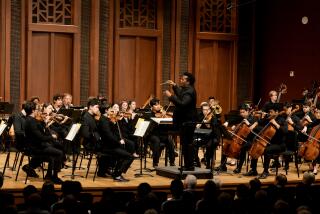SANCTIMONIOUS WHOOPEE : THE SECOND COMING OF ANDREW LLOYD WEBBER
- Share via
NEW YORK — Everyone knows and loves Andrew Lloyd Webber. He’s the clever British gentleman who made a superstar of Jesus Christ, a glamorous saint of Evita Peron and stylistic chameleons of a litter of show-bizzy cats.
Enter the new Andrew Lloyd Webber--an ever-so-somber, quasi-classical, lofty-toned, quintessentially commercial composer of sacred music.
Sunday night, before a dressy and devout invitation-only throng that included a former prime minister of Great Britain and that contributed $35 per head to the Holy Apostles Soup Kitchen, Lloyd Webber entered the magnificent portals of St. Thomas Church.
He didn’t enter alone.
He brought along television cameras; Humphrey Burton, formerly of Hollywood Bowl and still of the BBC, to warm up the crowd; stereophonic recording equipment; a high-powered public-relations apparatus; a tenorissimo called Placido Domingo; a starry maestro named Lorin Maazel; a bona-fide boy-soprano soloist, plus a woman soprano who sounded like a boy soprano (and who happens to be Mrs. Webber); two church choirs (one from St. Thomas, one imported from Winchester Cathedral); a symphony orchestra that included a synthesizer but no fiddles, and previews of instantly coming musical attractions in the form of a commemorative Angel recording.
The object of all this sanctimonious whoopee was Lloyd Webber’s new Requiem Mass.
In his musicals, Lloyd Webber has always been most effective when he was least pretentious. In the Requiem, he is most pretentious.
In his musicals, Lloyd Webber has often blurred the line between sincerity and parody. In the Requiem, he quotes and imitates so many other composers that the sonic tapestry resembles a crazy quilt.
Lloyd Webber may not be the most original of thinkers. But he does think big--you can’t take that away from him--and he is, without doubt, one of the most facile of stitchers. In fact. when it comes to stitching, he is a virtual virtuoso.
The stitching in the Requiem involves some stark would-be-purity in the style of Benjamin Britten (remember the “War Requiem”?) and some snazzy neoreligious funk in the manner of Leonard Bernstein (remember “Mass”?).
It involves some chugging Carl Orff ostinatos, some limpid Verdi Requiem lyricism, some innocent Faure Requiem molasses, some primitive Miklos Rozsa heroics and some slick Dimitri Tiomkin piety. This Requiem aspires to the pure fragrance of churchly incense, but it ends up reeking of cheap perfume.
No one can accuse Lloyd Webber of writing music that is ugly or monochromatic or ill-intentioned or inaccessible. One can accuse him, however, of writing music that gives eclecticism a bad name.
The performance at St. Thomas’, which utilized forces similar to those on the already well-sold recording, was classy--judging from what could be heard between the echoes.
Maazel emoted nobly for the folks in Televisionland (PBS will beam the event to the nation on Good Friday) and tried valiantly to make the simplistic seem profound. He elicited attentive responses from his double choir and from a nifty little orchestra from St. Lukes.
Domingo blasted his easy solos with the fervor of an artist equally at home with divas and Denvers. Sarah Brightman piped prettily, right up to an ethereal, vibratoless high D, unfazed by orchestrations that all but buried her fragile tone. Deprived of his recording microphones, Paul Miles-Kingston’s sweet treble evaporated in the vast open spaces.
To place the composition in its appropriate context, and to put the audience in the proper frame of mind for the world premiere, Lloyd Webber & Co. offered some choral music of Purcell and Bach as a prelude to the main event. Don’t cry for me, Johann Sebastian.
More to Read
The biggest entertainment stories
Get our big stories about Hollywood, film, television, music, arts, culture and more right in your inbox as soon as they publish.
You may occasionally receive promotional content from the Los Angeles Times.










